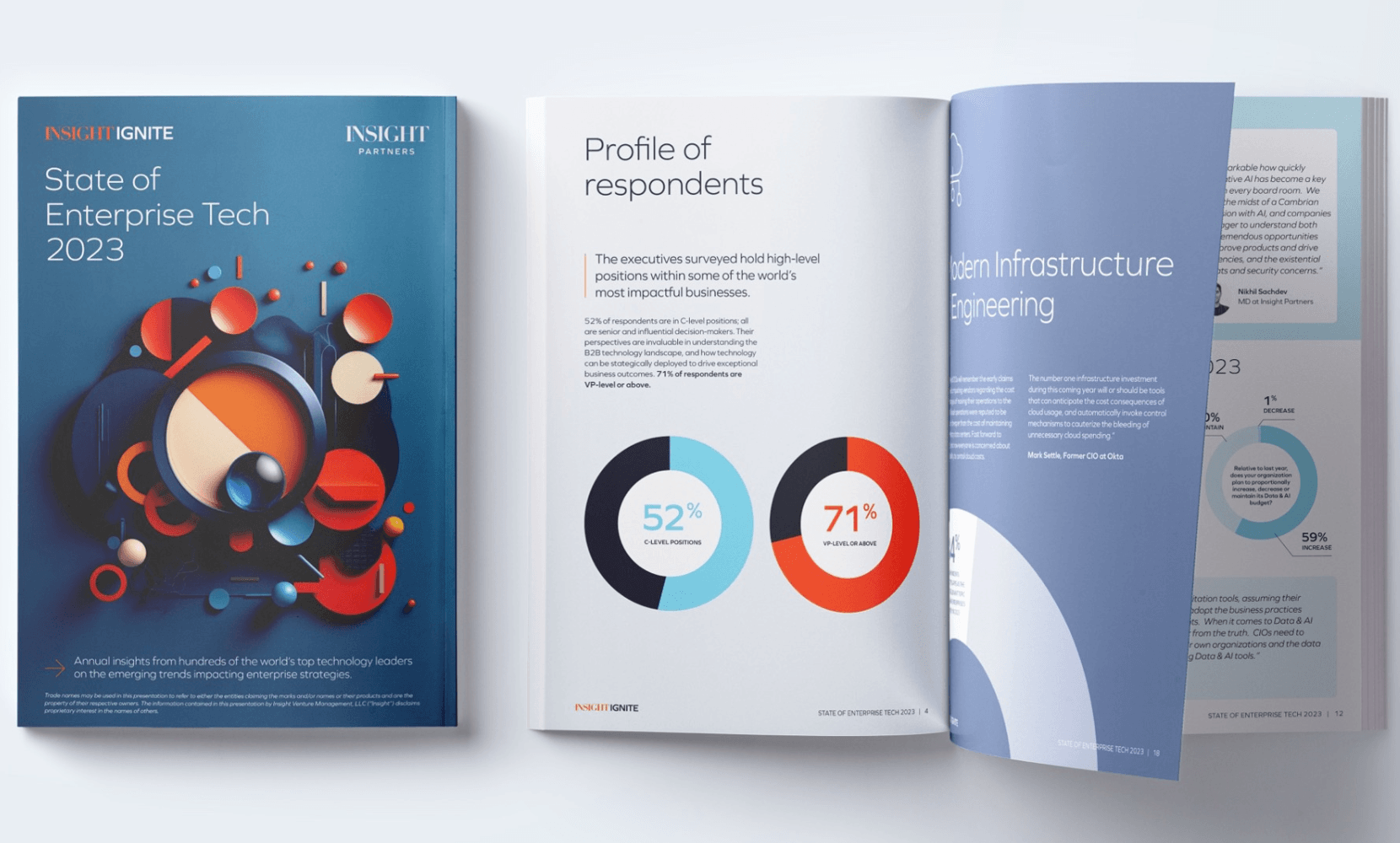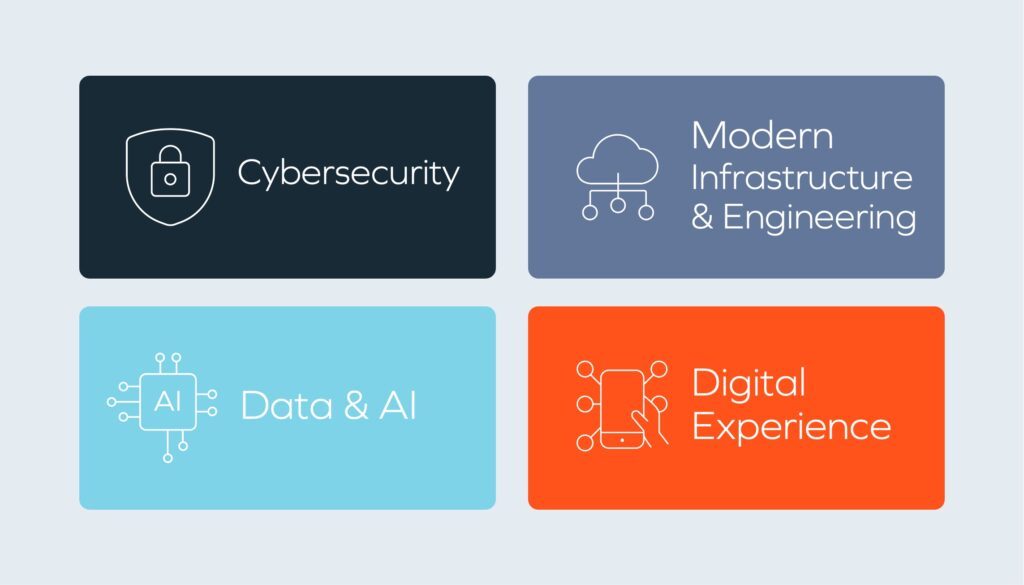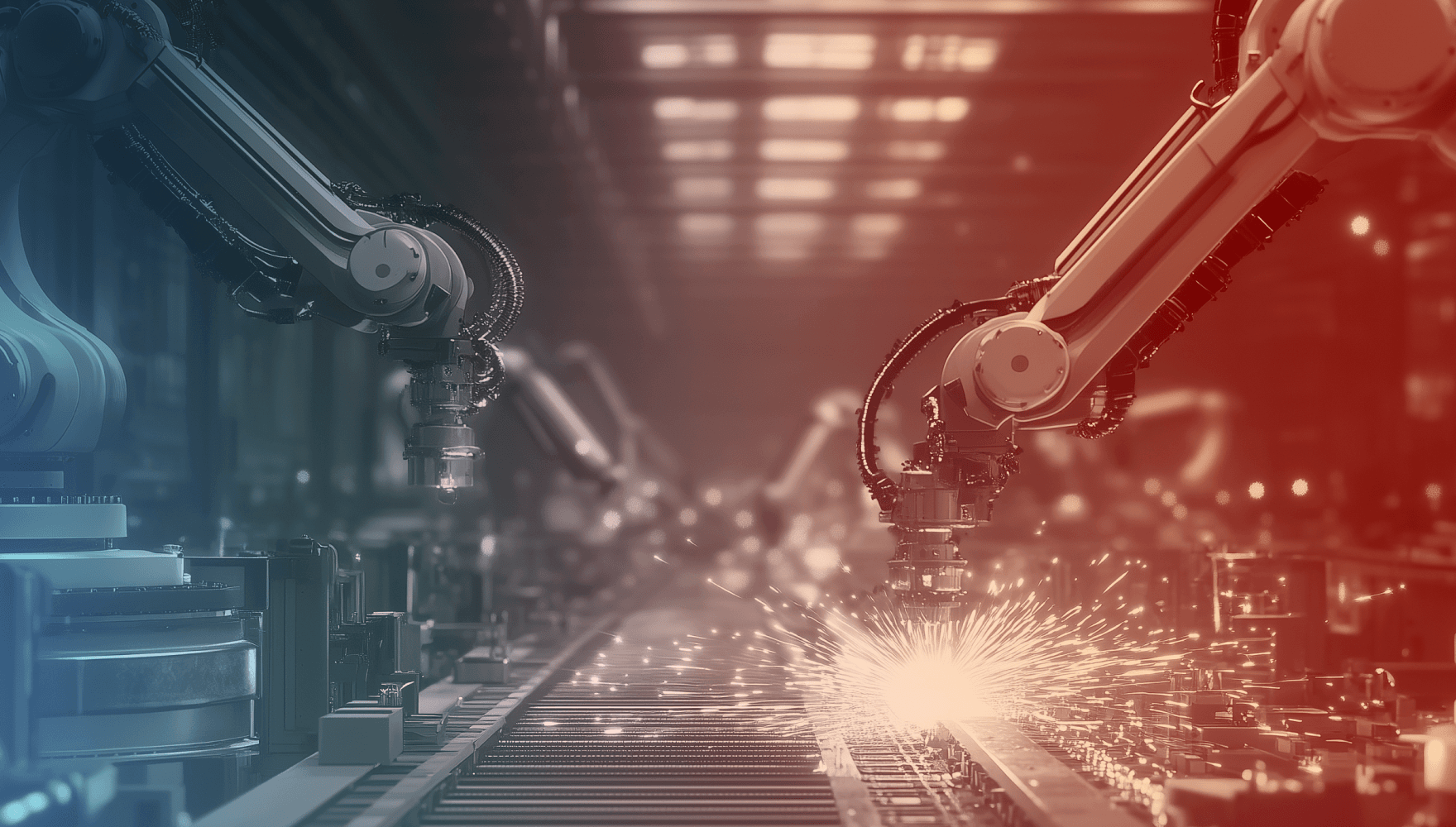New challenges, new solutions, new opportunities: Key findings from our State of Enterprise Tech report

Enterprises don’t stand still for long – and neither does the technology that supports them. Enterprise tech stacks and strategies are constantly evolving, as new challenges emerge and new solutions are developed in response.
Insight Partners is privileged to watch that digital transformation unfold in real-time – and to have access to the unique perspectives of the senior leaders driving the change. Insight has invested in over 750 startup and scaleup companies and, through its IGNITE network, has relationships with over 2,000 enterprise tech executives from more than 850 of the world’s leading businesses. Each year, we ask them to tell us what’s changing in how the enterprise leverages technology and share their insights in the State of Enterprise Tech report. 319 senior leaders from leading enterprise businesses at each stage of the digital maturity journey were surveyed.
This year’s report uncovers the top priorities for enterprise tech leaders, the tailwinds that are driving change, and the potential challenges enterprises will have to prepare for as they grow. It digs deep into the state of play for new technologies like generative AI, developing areas like API-first development, and existing challenges like data management and the digital customer experience.
We asked our network to rank their priorities within four key technology areas: Data & AI, Cybersecurity, Digital Experience, and Modern Infrastructure & Engineering. Here is what they shared – and what you need to know about the enterprise tech landscape as you strategize for the road ahead.

Data & AI: Generative AI debuts as a budget item
Data & AI is responsible for a significant rise in enterprise spending and is the technology area with the highest number of predicted budget increases. 59% of respondents reported an increase in their Data & AI budgets compared to the previous year. Priority areas include MLOps (42%), BI tools (24%), and modern data stack (19%) as enterprises prepare their data infrastructure to leverage AI in the future.
Unsurprisingly, generative AI is a popular topic in this year’s report, appearing as a budget item for the first time. 15% of respondents ranked it among the most relevant aspects of their Data & AI for 2023.
New use cases for generative AI are emerging every day. For many, the first step is using generative AI to create internal efficiencies, like simplifying engine mechanisms. But for others, generative AI is already driving real business outcomes and return on investment (ROI). Digitally mature businesses were the first movers, but now enterprises at all maturity stages leverage generative AI, and experimentation is happening across the enterprise. Infrastructure and engineering, cybersecurity, and digital experience teams are finding early success with use cases, including real-time threat intelligence, code generation, script optimization, and more.
Cybersecurity: Cloud security and consolidation are critical initiatives
Cloud-first architecture dominates cybersecurity strategies. Cloud & infrastructure security ranked top priority, with 34% of respondents overall and 44% of CISOs stating it was their first concern. As digital transformation changes the shape of the enterprise, new threat vectors emerge, and new SaaS solutions are added to the tech stack, IT and security teams are laser-focused on protecting their cloud environment.
This is becoming more challenging than ever. Earlier in the year, 98% of enterprise leaders were optimistic about maintaining or growing the budget allocation for cybersecurity. Now, external economic pressures are being felt, and budgets are being squeezed. This is exacerbated by the fact that cloud and infrastructure costs are now falling under the cybersecurity remit, forcing cyber leaders to do more with less.
As a result, cybersecurity teams are changing their tooling, looking for solutions that address vulnerabilities rather than only flagging them, and platform solutions that can replace one or more of the tools they already have.
Digital Experience: Enterprises seek new ways to understand customers
Unlike other areas, the goal for Digital Experience in 2023 is to play catch up, not break new ground. Understanding customer journeys in an omnichannel environment remains a challenge for enterprises of all stages: 65% of respondents said that digital customer experience was the most relevant aspect of their Digital Experience strategy.
Customer experience is seen as significantly more important than employee experience (18%) or enterprise automation (16%) – but that could change in the future as generative AI comes into play. These are areas where large language models could be used to automate tasks without the need for coding or improving personalization.
In this context, robotic process automation (RPA) could become obsolete. Many enterprises are starting to consider how their tools and processes might need to change in order to drive efficiencies in the future.
Modern Infrastructure & Engineering: APIs dominate in the future of software development
Modern Infrastructure & Engineering budgets are still growing, but at a slower pace than the other three technology areas: only 37% of enterprise leaders said they were planning to increase their budget. That’s likely because modern Infrastructure & engineering has seen so much investment in recent years as enterprises began transitioning to the cloud. With those programs ongoing, investment is now relatively flat.
Enterprise attention is on APIs. As they grow, APIs are becoming critical tools for internal interaction and enabling seamless integration across the SaaS stack. 34% of respondents ranked APIs as the most relevant aspect of their Modern Infrastructure & Engineering strategy. API-first development is revolutionizing the software development process and, as generative AI makes it easier to create APIs, adding firepower to developers’ efficiency and productivity.
DevSecOps is another focus area in the enterprise: it was named as a priority 83 times. DevSecOps bridges the gap between Security and DevOps teams and ensures security is baked into software development from the outset.
Opportunities for enterprise leaders and innovative founders
The new state of enterprise tech reveals opportunities for both enterprises and innovators.
For enterprises
- Consolidating, aggregating, and organizing data, and ensuring strong governance around it, will smooth the path to effectively implementing it across the business and unlocking AI use cases. Investment in modern data stacks and MLOPs is critical to ensure a strong base layer of private data so that enterprises can start to deploy machine learning and generative AI solutions.
- Securing cloud platforms and managing access to them can help drive efficiencies down the line. As cloud architecture evolves, so too should security paradigms in order to mitigate future data and compliance risks.
- API-first development is revolutionizing the way enterprises adopt software. Those that can move to API-first models are likely to move faster, eliminate risks earlier, and create better products. Enterprises should first look at organization design systems and communication mechanisms before attempting to change their architecture, or risk misalignment with their existing talent pool.
For innovators
- Insight predicts that as AI continues to evolve, much of the value creation will be in adjacent technologies that support the organization, discovery, and mapping of underlying data. Solutions that meet these needs are likely to see exponentially increasing demand.
- Innovators that take a platform approach to meeting the need for enhanced controls while minimizing net new tooling are already seeing traction. Against compressed cybersecurity budgets, cybersecurity solutions need to prove they drive efficiency as well as security.
- For innovators building APIs, ease of integration with existing apps and systems should be the highest priority. Enterprise decision-makers expect efficiency and security; removing complexity from their SaaS stack is a substantial value add.
The changing state of enterprise technology
As innovation accelerates and internal and external contexts shift, the state of enterprise technology continues to evolve. Enterprise leaders are re-strategizing and re-tooling to meet new challenges, minimize risk, and open up new revenue streams.
Insight Partners’ State of Enterprise Tech report digs deep into why and how – and what businesses across the ecosystem can do to keep ahead of the curve.







